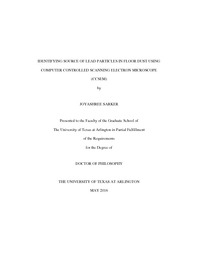
ATTENTION: The works hosted here are being migrated to a new repository that will consolidate resources, improve discoverability, and better show UTA's research impact on the global community. We will update authors as the migration progresses. Please see MavMatrix for more information.
Show simple item record
| dc.contributor.advisor | Hunt, Andrew | |
| dc.creator | Sarker, Joyashree | |
| dc.date.accessioned | 2016-07-08T21:07:42Z | |
| dc.date.available | 2016-07-08T21:07:42Z | |
| dc.date.created | 2016-05 | |
| dc.date.issued | 2016-05-10 | |
| dc.date.submitted | May 2016 | |
| dc.identifier.uri | http://hdl.handle.net/10106/25810 | |
| dc.description.abstract | Identifying the sources of lead (Pb) in indoor dust by analysis of the contents of the dust provides an opportunity to mitigate the source of contamination. In this study, it is hypothesized that in residential properties where there exist the potential for friction surfaces to contribute old lead-based paint to the dust such material can be identified by microscopic examination of the dust. Although old lead-based paint in such circumstances can be implicated, without studying the dust it is impossible to know whether some other contributing source may be important. Exterior soil and dust that potentially can enter the home may be the source(s) rather than the obvious friction surfaces. Here an electron microscopy based method of dust analysis is used to apportion the sources of the lead in dust. A total of over 10 older homes were selected from urban Syracuse, New York, and the samples collected from those houses were analyzed using computer controlled scanning electron microscope (CCSEM). Furthermore, to evaluate the reasonableness of this method two other measurement techniques: (i) lead isotope composition (PbIC) determination and (ii) bulk sample element concentration measurements (by X-ray Fluorescence analysis (XRF)) were used to provide comparable source attribution results but by alternative means. A source un-mixing model was used to resolve the PbIC data, while a chemical mass balance model (CMB) was used to apportion the receptor site lead to the potential contributing sources.
A descriptive apportionment was used to assign dust lead particles to possible sources in the CCSEM approach. It was felt that this method provided the best source resolution. Under the best conditions we calculated that ≥ 70% of the lead particles in a dust could be attributed to (what we considered) the actual contributing source. It was also concluded that if one added these unattributed lead particles to the paint source particles, then the accuracy of the descriptive apportionment would be high in most situations like those investigated here. | |
| dc.format.mimetype | application/pdf | |
| dc.language.iso | en_US | |
| dc.subject | Floor dust | |
| dc.subject | Lead | |
| dc.subject | Lead based paint | |
| dc.subject | Childhood lead poisoning | |
| dc.subject | Computer Controlled Scanning Electron Microscope (CCSEM) | |
| dc.subject | X-ray Fluorescence (XRF), | |
| dc.subject | Lead Isotope Composition (PbIC) | |
| dc.subject | Chemical Mass Balance model (CMB) | |
| dc.subject | Discriminant analysis | |
| dc.subject | Descriptive analysis | |
| dc.title | Identifying Source of Lead Particles in Floor Dust Using Computer Controlled Scanning Electron Microscope (CCSEM) | |
| dc.type | Thesis | |
| dc.degree.department | Earth and Environmental Sciences | |
| dc.degree.name | Doctor of Philosophy in Earth and Environmental Science | |
| dc.date.updated | 2016-07-08T21:08:13Z | |
| thesis.degree.department | Earth and Environmental Sciences | |
| thesis.degree.grantor | The University of Texas at Arlington | |
| thesis.degree.level | Doctoral | |
| thesis.degree.name | Doctor of Philosophy in Earth and Environmental Science | |
| dc.type.material | text | |
| dc.creator.orcid | 0000-0002-8561-6212 | |
Files in this item
- Name:
- SARKER-DISSERTATION-2016.pdf
- Size:
- 17.09Mb
- Format:
- PDF
This item appears in the following Collection(s)
Show simple item record


